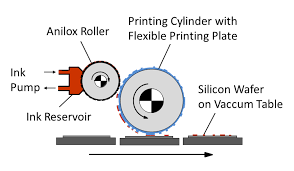
Flexographic Printing
U.S. production facilities most common as surface print on a paper substrates.
Flexography (often abbreviated to flexo) is a form of printing process which utilizes flexible relief plate. It is essentially a modern version of letterpress which can be used for printing on almost any type of substrate, including plastic, metallic films, cellophane, and most commonly paper. It is widely used for printing on the non-porous substrates required for various types of food.
Platemaking
The first method of plate development uses light-sensitive polymer. A film negative is placed over the plate, which is exposed to ultra-violet light. The polymer hardens where light passes through the film. The remaining polymer has the consistency of chewed gum. It is washed away in a tank of either water or solvent.
The second method uses a computer-guided laser to etch the image onto the printing plate. Such a direct laser engraving process is called digital plate making.

Printing Flexographic printing is made by creating a positive mirrored master of the required image as a3D relief in a rubber or polymer material. Flexographic plates can be created with analog and digital platemaking processes. The image areas are raised above the non- image areas on the rubber or polymer plate. The ink is transferred from the ink roll which is partially immersed in the ink tank. Then it transfers to theanilox or ceramic roll (or meter roll) whose texture holds a specific amount of ink
Think flexographic printing is right for your business needs?
Think flexographic printing is right for your business needs? Click here to get a Custom Quote or Request Samples!



